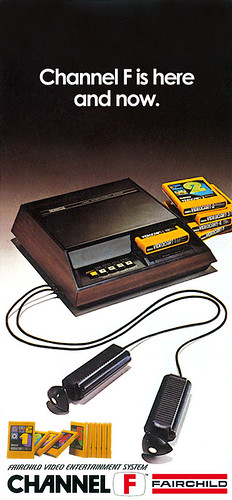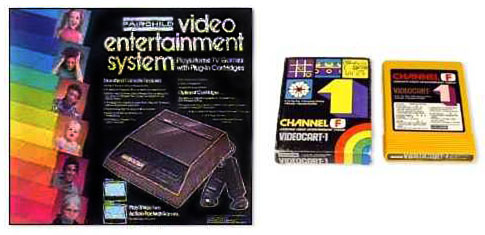Fairchild Channel F 101: A Beginner’s Guide
Note from racketboy: Racketboy contributor, Ack strikes again with another beginner’s lesson in pre-NES gaming hardware — this time we take a look at the Fairchild Channel F. BTW, The RetroGaming 101 series is aimed at gamers who are just starting out in the classic gaming scene or are curious about an older console that they don’t know much about yet.
The Fairchild Channel F released in August 1976, at $169.95. Though it is often overlooked in the history of gaming, the Channel F would bring about a revolution in console design, changing the home video game market for the next twenty years. It was originally released by Fairchild Semiconductor, and would be their only console release.
 Background Information
Background Information
- The Channel F’s original name was the Video Entertainment System, but was changed to Channel F when Atari released the VCS(Atari 2600) in 1977.
- Though Atari was testing their prototype “Stella†at the time, the release of the Channel F would spur them to push for an earlier release then they had planned.
- To fight Atari effectively, Fairchild began a redesign of the console, which would later become known as the Channel F System II. When the game market slumped in the late 1970s, they decided to give up on the project, and sold it to Zircon International, who released it in 1979.
Historical Impact
- This console was the first to use ROM-based cartridges, something that would serve as a mainstay in the home console industry until the Nintendo 64 and Super Famicom stopped production.
- The console also forced Atari to release the Atari 2600 to stay competitive. This served as one reason why Atari was purchased by Warner Communications.
- The console also featured a “Hold†button, which would stop the action on screen. This was a precursor to the “Pause†function.
- The Channel F also appeared on TV POWWW, a television game show.
Strengths
- All cartridges for the console were numbered, and the count was kept low. Fewer than 30 cartridges were ever formally released, so collectors will have an easier time figuring out what they’re missing. Several carts contain more than one game.
- The original design incorporated a holding space for the controllers, both of which were hardwired to the console.
- The console also saw release in different European nations under different names, and with different games, though these were also numbered.
- The console also had a newsletter, published only once in October 1977. It gives detailed information on the first 9 carts, and also previewed carts 10-12 for their November 1977 release.
- The controllers were very simple, literally 4-way joysticks on grips that could also be pulled up or down and twisted left or right for 8 different movement methods.
- Two Pong clones, called Tennis and Hockey, were built into the console and could be played without a cartridge.
Weaknesses
- The original Channel F had a speaker built into the console, though it’s of poor quality. The later version instead used television audio. The Atari 2600 had better audio overall.
- The controllers suffer from cheap copper wiring which can break easily and is difficult to replace.
- Graphically the console was weaker than the Atari 2600, and it shows.
- The game library is extremely limited.
- Though a keyboard accessory was unveiled in a sales brochure for the console, it was never released, so there are no accessories for the console whatsoever.
Hardware Specifications
- The Channel F utilizes the Fairchild F8 8-bit microprocessor chip. The processor speed is 2 MHz.
- Game resolution is 128 x 64 pixels, though only 102 x 58 are visible.
- The machine boasts 64 bytes of RAM, with 2 kB of VRAM.
- The console carries a max of eight colors, but only a max of 4 per line.
- The Channel F audio output is capable of 500 Hz, 1 kHz, and 1.5 kHz tones.
- The output is a RF modulated composite video signal, with the cord hardwired into the console. The power supply is external.
Hardware Variations
- The Fairchild Channel F incorporated a built-in speaker, hardwired controllers, and a very 70s design.
- The Channel F System II moved the location of the storage compartment for the controllers, and also lost the internal speaker. The controllers were also removable. It keeps the same chip set as the original.
- The Adman Grandstand was the name for the United Kingdom variant of the Channel F, though it looked considerably like the Channel F System II.
- The Barco Challenger is the Belgium variant, which was exactly the same as the Italian variant, the Dumont Videoplay.
- The Luxor Video Entertainment System was the name of the Swedish variation of the console.
- Pictures of the different variations can be found on Pink Godzilla’s blog
German Variations
- Germany would see the Saba Videoplay in 1978.
- This would quickly be followed by the Saba Videoplay 2, which featured slightly different controller design and lacked the internal speaker.
- The ITT Telematch, again with modified controllers and a redesigned case, would be released in 1978. It would be the only one without an EJECT button.
- The Normende Teleplay would follow these a year later in 1979 with a stylish silver paint job.
Emulation
- The Fairchild Channel F can be emulated with the MESS emulator.
- There is also a homebrew community for the Channel F. Their wiki is located at VESWiki.com.
Affordibility
- The Channel F is often overlooked, so usually prices aren’t too bad. (Between $30 and $50 on eBay depending on condition and packing included) The age of the console works against the buyer, however.
- The Fairchild Channel F also doesn’t appear very often on auction sites, so finding it can be difficult. Â (2 systems listed on eBay at the time of this publication)
- Individual cartridges can vary in rarity. Â Some games can be found on eBay currently for around $5 each
Affiliate programs and affiliations include, but are not limited to, the eBay Partner Network or Amazon Associates.


The Fairchild huh? Only thing older is the original Odyssey and the Pong machines. But this guy was probably the most important contributor outside of the 2600, as this guy gave us the cart.
Minor correction (typo?):
One of the German companies to release a variant of the Channel F was called “Nordmende”, not “Normende”.
Interestingly, Nordmende was a well-known German producer of TV sets back then, like Saba and Grundig.
Grundig sold a variant of the Interton VC-4000 console (which originated from chipmaker Signetics – a Philips company), called the “Grundig Super Play Computer 4000”, which could only be connected to Grundig TVs through a proprietary RGB-interface (supposedly offering a very good picture quality).
They apparently saw the consoles as extensions of their TV sets, as accessories if you so will – and a way to participate.
However, all these consoles seem to be weaker than the Atari 2600 and AFAIK apart from Philips (Magnavox Odyssey = Philips G7000, next gen = Philips G7400+) none of the TV makers ever brought out a second, better generation. We may never know if the video game crash or their own failed marketing attemps are responsible for that.
Kinda want one of these just like I want an odyssey probably would barely if at all play it but would like to have one if only for awhile. Collecting atari and vectrex stuff though right now which is eating up all my $$$
I’ve never even heard of this thing. Thanks for the info, Ack.
I have one of these. The controllers are… unique, which is really the most interesting thing about the system. The games are pretty poor too, nothing much better than Combat, which is better on the 2600 anyway. Really, not much to recommend it besides owning a piece of video game history.
Good article, didn’t know much about this one.
You write: “Germany would see the Saba Videoplay in 1978, which would lack the internal speaker and would feature an “Eject†button for cartridges.”
I’m pretty sure that SABA Videoplay has an internal speaker also and 100% sure that the SABA Videoplay 2 does not.
ALL clones of the Fairchild System has an EJECT-button except the ITT Tele-Match Processor.
My dad brought me one of these home one day when he was out at garage sales. In the box with all manuals and in great shape. Also had a couple boxed games. Still works. Pretty cool to own this piece of gaming history no matter how obscure it is to most people.
I have one in “fair” shape I bought for $5 at a junk shop years ago. Many of the carts have peeling contacts and are unusable without the intervention of a skilled solderer. The joysticks have a rectangular head with little indication of up/down/left/right. The only sound is clicks from the console, which leaves the TV audio to just a bunch of processor noise. Love the retro colors, though. The pea green and dark yellow with just a little bit if distortion is so ’70s!
@MrPopo- Actually, the Channel F (Fairchild Video Video Entertainment System, as it was originally called until the name was changed because of the Atari VCS) is older than a lot of pong consoles, including the Maganvox Odyssey 300, Coleco Telstar, Atari Super Pong, and more. The biggest reason it failed was the video game crash of 1976.
(Exclude the extra “video”)